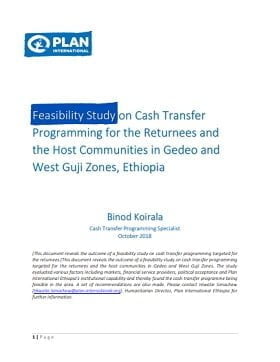Feasibility Study on Cash Transfer Programming for the Returnees and the Host Communities in Gedeo and West Guji Zones, Ethiopia
Since April 2018, insecurity and localised conflict between communities in Gedeo Zone (Southern Nations, Nationalities and Peoples’ Region– SNNPR) and West Guji Zone (Oromia Region) led to a rapid displacement of 960,000 people (IOM Displacement Tracker, August 21, 2018). Assets and livelihoods have been lost, education disrupted, protection concerns have arisen and other basic services and infrastructure damaged. Houses were burned, and people were forced to flee quickly. As a result of the conflict, girls and boys have not been able to complete the academic year, and if schools remain occupied by IDPs, this will also affect the start of the next academic year. Moreover, the region is still responding to the drought since 2015, and recently flash flooding is also impacting the region, with Oromia and SNNP regions with the highest at-risk population. This is against the backdrop of intercommunal violence continuing along border areas of the Oromia and Somali.
The National Disaster Risk Management Commission (NDRMC) and UNOCHA have been leading the coordination of humanitarian assistance and all sector cluster leads and partners have conducted initial rapid assessments. The government initiated a voluntary return of IDPs to their home areas since late August with the intent that all IDPs have returned by the end of September. They are also putting pressure on UN agencies and NGOs to focus on rehabilitation and recovery of returnees.
In general, there is a growing recognition of cash transfers across the global humanitarian sector that can support people affected by disasters and conflicts in ways that maintain human dignity, provide access to food and shelter and help rebuild or protect livelihoods. The question is no longer valid whether cash is an appropriate way to meet the needs of people engulfed in crisis, but how organizations, donors and governments can use cash transfers to best effect.
Ban Ki-moon, the then UN Secretary-General in his report “One Humanity, Shared responsibility“ during the World Humanitarian Summit, 2016 highlighted that “cash-based programming supports the people by allowing them to purchase goods and services they need most while also supporting local economies. Where markets and operational contexts permit, cash-based programming should be the preferred and default method of support.” Top donors and aid agencies (53 signatories) in 2016 under Grand Bargain in the same summit committed to making humanitarian aid more efficient, and generally endorsed a shift towards greater use of cash transfers. CTP can contribute immensely in facilitating smooth return of refugees and IDPs who need to purchase assets, secure housing and continue or restart their livelihoods. In Afghanistan, a cash grant of USD 100 per person has been an important component of Voluntary Repatriation Programme since 1990.
Available literatures suggests the CTP is an effective modality in multi sector response programmes for internally displaced people (IDP) and refugees in a wide variety of contexts-from Syrian, Iraqi, Palestinian refugees in surrounding countries to IDPs in Central African Republic, Nigeria Mali and Northern Uganda. CTP have also been used in urban displacement contexts. An evaluation of UNHCR indicates that “cash” as a modality of emergency response is effective, efficient, flexible and hence popular choice amongst refugees, which empowers them to make their own decisions and accord dignity. Cash has also been effectively used in response to displacement in urban settings, including Port au Prince, Nairobi and New Orleans and also in rural settings in Mali, Nigeria, Niger and also it is being initiated in Central African Republic.
CTP can contribute immensely in facilitating smooth return of refugees and IDPs who need to purchase assets, secure housing and continue or restart their livelihoods. In Afghanistan, a cash grant of $100 per person (as of 2007) has been an important component of UNHCR’s Voluntary Repatriation Programme since 1990. In Ethiopia, WFP found that cash transfer is 25 to 30 % cheaper than that of in-kind. Another study carried out in four countries suggests it being 13-23 % less. When there is a scope of use of mobile phone, the costs could be as cheaper as 90 % as seen in Kenya.
Humanitarian actors including Plan International (PI) by now have realized a growing importance of Cash Transfer Programming (CTP). Plan International Ethiopia (PIE) has prepared a Response Plan with an aim of assisting the IDPs in Gedeo and West Guji Zones. However, as the context is changing rapidly, PIE is now updating the Response Plan with the returnees and the host communities being principle target population for its response and recovery. The Response Plan has already acknowledged the cash being a useful modality of support should the other factors remain favourable. In order to understand its scope further, PIE conducted a feasibility study on CTP (September 2, 2018-October 2, 2018) in Gedeo and West Guji keeping the returnees and the host communities as centre of its target.



